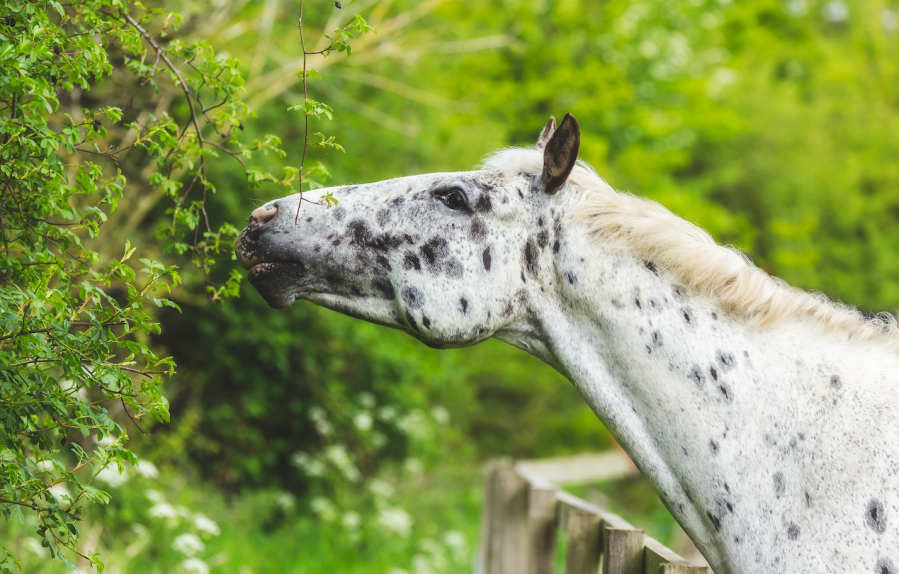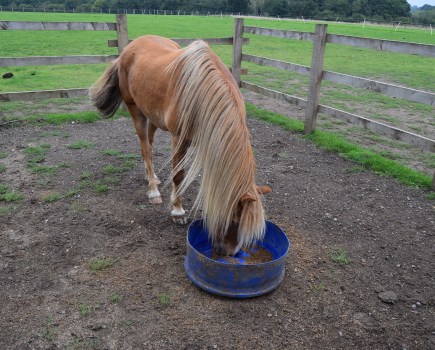After a long dark, cold and wet winter, the promise of spring is a particularly exciting time for horse owners and riders. Warmer and drier weather not only gives us — and our horses — longer days to spend more time outside, it also provides the ideal opportunity to carry out those tasks that might have been neglected during the cold, short days of winter. Your Horse asked the British Horse Society (BHS) for the spring jobs it recommends ticking off the to-do list at this time of year, as they all play an important role in helping you do a great job of taking care of a horse.
First and foremost, spring is the ideal time to give your horse a general health MOT and assess how well they have come out of winter. “If you’ve not been keeping track of your horse’s weight over winter, now is the time to start,” says the BHS. Regularly fat scoring your horse will help them maintain a healthy weight through the spring grass growth and enable you to keep an eye on any weight gain, in order to reduce the risk of obesity-triggered health problems like laminitis and equine metabolic syndrome.
Warm, wet springs can cause dermatitis and bacterial infections in some horses, so monitor your horse for skin conditions. It will soon be sweet itch season too and prevention is better than cure, so seek advice from your vet now if you need it. Consult your worming schedule to check which worms your horse needs to be tested for now. Check when vaccinations for equine flu and tetanus are due and make sure an equine dental technician, or vet, has checked your horse’s teeth in the last six months. The amount of horses suffering with grass sickness peak in late spring, so make sure you’re clued up on the signs of this killer disease.
Rest winter fields and paddocks
The end of winter is generally when your paddocks are looking their poorest and access to grazing may still be limited throughout the spring, so plan how to manage your horse’s needs with the recovery of your fields.
“Dividing your paddocks with electric fencing enables you to rest some areas, tackle weeds and drainage, and re-seed any areas that are badly poached,” advises the BHS.
Spring is also the best time to install grass mats or mesh in any gateways that tend to become a quagmire over winter.
“Taking some time now to ensure that your grazing areas are free from poisonous plants like ragwort, as well as reporting any at nearby roadsides to your local authority, can be beneficial — don’t wait for later in the year when it’s had a chance to flower,” says the BHS. “Uproot the rosettes as soon as you spot them and burn them. When handling ragwort ensure you wear gloves.”
Check fences, pipes and yard equipment
Spring is a great time to ensure your fencing is in good repair and that you replace any part of it that is broken, weakened and/or might be approaching the end of its life. “Also check your property boundary for any other areas that need attention, such as clogged ditches and field drains which can add to flooding,” advises the BHS. “Hedges make a big contribution to your horse’s shelter, shade and diet, and should only be cut between 31 August and 1 March in the UK to protect birds nesting in the months in between. If you’re too late this spring, mark hedge cutting (or hedge laying if the bottom is looking thin) in your diary for autumn. You can fill any gaps with young ‘quicks’ (saplings) of trees like hawthorn or hazel.”
Spring is the best time to turn your attention to anything on the yard or in the field that has suffered wear and tear during the winter months. Replace broken light bulbs, lubricate sticky padlocks and replace bent door hinges. If your mucking out tools have seen better days, consider replacing them or giving them some TLC, and the same with plastic water and feed buckets and string haynets.
“If frozen taps were a problem over the winter, look at how you might be able to improve the lagging and insulation of pipes ready for next year,” recommends the BHS. “It makes sense to book any maintenance visits during the shorter days if you can, so make appointments for things like your regular electric safety PAT testing check. Have any equipment and machinery like tractors, quad bikes and toppers serviced and overhauled now if you haven’t had them done during the winter.”
Have a tackroom sort out
After rushing around all winter and battling the short daylight hours, the tack room may resemble a war zone more than a neatly organised place to keep expensive saddles and bridles. Once the mud has finally dried up, give your tack room a good dust, de-mud and clean, as well as a thorough tidy. Go through your piles of unused tack, equipment and rugs, and sell or pass on what you don’t use. Any extra pounds you make could go towards your hay or bedding costs next winter.
Give your leather work a good clean and feed with a nourishing leather product. Wet, muddy conditions can dry leather out and cause it to crack and snap; treating it with a good quality leather feed will replenish its moisture and keep it supple and strong. While doing this, look out for damage such as loose stitching around buckles or cracks, which will need repairing.
Spring is a good time to reassess how your saddle and bridle fits your horse — book a qualified saddle fitter to visit and advise you. Horses change shape which can affect tack fit, which needs identifying in order to do what you can to ensure they are comfortable when ridden.
Give your stable a spruce up
With warm days and a fresh breeze, the fields will be drying out and, hopefully, your horse is enjoying more turnout time. This is the ideal time to give your stable a deep-clean — it doesn’t just look good, but it’s good for your horse’s health (and yours) too.
“Remove any rubber matting and wash down the walls and floor with a disinfectant and a good scrubbing brush,” says a spokesperson for the BHS. “This will kill any germs and bacteria that builds up and leave your stable smelling fresh and clean.”
Choose a warm, sunny day to make sure your rubber matting and floor in the stable are fully dry before putting it all back.
Sort out the arena, muck heap and water troughs
Think about clearing out your muck heap if it has built up over the winter months. Your local farmer might be interested in the waste as fertiliser, otherwise, you may have to pay a local contractor to do the job for you. With horses spending more time in their paddocks, check the state of your water troughs. Clear out any debris and give them a good scrub to remove any algae and slime from the sides and bottom.
Give your arena some TLC now too. Check the drainage, the fencing around it, the membrane and the quality and depth of the surface and make any alterations as necessary.
Rearrange your horse’s wardrobe
The wet and mud of winter are replaced by dust and flies in the summer months, so once you have safely stored your horse’s winter clothing, now is the time to start bringing out your horse’s lighter weight rugs, fly rugs and fly spray. Check rugs are clean and in good working order and restock on fly spray if necessary. In your home, do the same with your own winter clothes. Wash and store them away and replace them with your cooler summer items.
Winter rugs take a battering in the winter, with turnout rugs being exposed to excessive water, sticky mud and often rips and tears, while stable rugs endure months of exposure to urine and droppings. Once the warmer weather arrives, it’s easy to pile them up in the tack room and forget about them, but smelly, dirty rugs won’t clean or repair themselves.
“Try not to put off washing, re-proofing and repairing all your rugs until autumn — send them off now so you can relax knowing they are ready to go once the colder weather sets in,” says the BHS. “Check them over for any small rips or tears, or loose or broken straps and get them repaired to ensure the rug’s longevity.”
Getting this done now will avoid the rush — and possibly delays due to high demand — in getting winter rugs washed, reproofed and repaired in the autumn. Store rugs clean and folded, somewhere dry and rodent-proof.
Get clippers sorted now
Don’t wait for the autumn rush — send them away now! Your clippers will benefit from a service and blades need a sharpen. Once they are returned to you, make sure they are fully dissembled, with the blades wrapped up to keep them dry, and store them in a warm, dry place to prevent them rusting.
Check your fire safety procedure
Any yard can catch fire, so every yard should have a fire safety procedure — even if it’s just you and your horses on site. If you know what to do and how or where to take your horse(s) to safety in the event of a fire, you’ll be able to act quickly to the potentially dangerous situation. Make sure there is at least one fire extinguisher on your yard; check it is in date and make sure you know how to use it.
Cobwebs and dust in stables and yard buildings, alongside dry hay, straw and shavings, are the perfect recipe fore a fire, so spend some time dusting and de-cobwebbing. Wear a face mask to prevent you from breathing in the dust. A hat and overalls will stop you being covered in cobwebs and dust when clearing overhead.
Give your horsebox or trailer the once over
If you’re lucky enough to have your own horse transport and it hasn’t done a lot over the winter, now is the time to check its health. Ideally book it in for a service and also make sure your insurance and breakdown cover are up to date.
“Take a really good look around both the outside and inside of horse boxes and trailers for any obvious signs of rust, damp patches and rotting, as well as paying close attention to the tyres,” advises the BHS. “Check tyre tread, condition (ie no cracks) and pressure. The electrics, lights and breakaway cable will also need an inspection before you set off, and oil levels and battery health also need checking.”
Love hacking? Join our free #Hack1000Miles challenge and see how far you can go!
Subscribe to Your Horse Magazine – the perfect Christmas gift!
Find out what’s inside the latest issue of Your Horse









